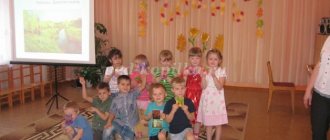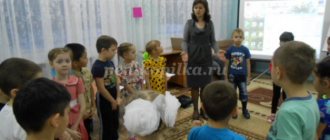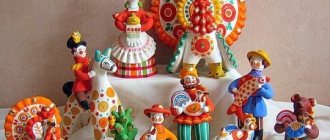Thematic music lesson at a preschool educational institution. Senior group
Summary of a music lesson for children 5-7 years old. We sing, knock, play - we strengthen our health!
Direction: development of musicality, preservation of physical and psychological health.
Educational field: music. Integration of educational areas: music, communication, socialization, health, cognition, physical education. Goal: comprehensive development of cognitive processes and musical abilities of children of senior preschool age through the use of pedagogical health-saving and infrared technologies. Objectives: educational: -improve vocal skills and pitch hearing in the process of singing activity; — improve timbre hearing, strengthen children’s ability to distinguish and determine the sound of musical instruments; - encourage children to be active in musical and speech activities; — enrich children’s speech by including in the vocabulary words that define the nature of music. developing: - develop a sense of rhythm, auditory attention, - promote the development of memory, logical thinking, imagination; — improve speech motor skills; — develop children’s creative activity and communication skills. educating: - to cultivate a culture of listening, a love of music, a desire to engage in musical activities; — cultivate a culture of communication and a sense of empathy; - encourage children to perform motor improvisations; — to develop children’s emotional responsiveness to feelings and moods expressed in music. health-saving: - creating a positive psychological atmosphere in class, reducing emotional stress; — increasing children’s self-esteem, their confidence in their own strengths and performance results (individual and collective); — formation of motivation for creative self-expression in the process of collective activity; — learning the basics of proper singing breathing, expanding lung capacity; - reduction of visual tension; — formation of a conscious attitude of children towards their health and development of their own health improvement skills; - reducing muscle tension by teaching the basics of play self-massage. Planned result: - establishment of a friendly relationship (teacher - children); — creating and maintaining a positive emotional background throughout the lesson; — learning a new song and then performing it; - formation of stable habits for a healthy lifestyle in children; — mastering the skills of self-massage and self-regulation. Progress of the lesson: Children enter the hall where they are met by the music director. Musical director: - What kind of guests are rushing into the hall? I'm glad to see you guys! Let's gather in a friendly circle: (everyone gathers in a circle) On the right is a friend, and on the left is a friend! Hello my friends! Today I want to ask you this. When you come to kindergarten, what do you say to those you meet? (children's answers) That's right, all well-mannered people, when they meet, wish each other health - they say... “Hello.” And today I invite you to greet each other in an unusual, musical way. Our musical greeting is a song - an echo. Where can you find an echo? (children's answers) What does the echo do? (children's answers) That's right, it repeats everything. Now you will become my echo. I will sing a musical phrase, and you will repeat it like an echo. And when I raise our clasped hands up, we will all loudly shout “Hurray!” Is the task clear? 1. Musical greeting “How great!” (author of words by E. Plakhova) (unaccompanied): MR: - It’s great that we all gathered here, gathered! Children: - It’s great that we all gathered here, gathered! MR: - Smile at your friends, Smile, smile! Children: - Smile at your friends, Smile, smile! MR: — All friends gathered together! Children: - All friends gathered together! All: - Hurray! Musical director: - Well done! So we greeted each other and everyone present in the hall! And now... 2. Self-massage “Voice, wake up!” (author E. Plakhova) Let's clap a little... (clap hands) And rub our palms... (rub our hands together) And now even harder, To make it hot! (rubbing your palms more quickly and intensely) From bottom to top... from top to bottom... (stroking movements with fingertips on the neck) Our little voice, wake up! (clap their hands) From top to bottom... from bottom to top... (stroking movements with fingertips on the neck) Success awaits us in singing! (clap their hands) Guys, what holiday will we celebrate soon? That's right, New Year is coming soon. And on New Year's Day it is customary to give gifts. My friends, do you like gifts? (answers) I also have a gift for you today, but not a simple one, but a musical one... Sit down near the piano... (children sit down) My gift is a new song... Sit down comfortably... 3. Express learning of the song “Sleigh” (music by A. Filippenko, lyrics by T. Volgina) using mnemonics. (learning takes place sitting on chairs, and the final performance standing MR reminds children of the singing position, of posture) Musical director: - You sang the song perfectly! Our efforts were not in vain! And while you were all working, were your eyes tired? No problem! We will help them! Let's give them a massage too! Get in order! Let's do some exercise for your eyes! 4. Visual gymnastics “Christmas tree”: Here is a big tree, this height. (Perform eye movements from bottom to top) It has large branches. This is the width. (Moves the eyes from left to right) At the top there are big bumps, (Eyes up) And at the bottom there is a bear’s den. (Eyes down) The clubfoot sleeps there during the winter And sucks his paw in the den. (Close their eyes) Musical director: - Well, our eyes have rested. Guys, did you like how we sang the wonderful song “Sleigh”? (children's answers). We all sang together, so what did we sing? (in chorus) Guys, do you think it’s possible to sing music... with your hands? (children's answer) Let's try? Look what I have prepared for you: for girls - these wonderful flowers that are put on your hand like this... And for you, boys - these moths. Please take a seat in our hand choir. Girls, please sit down on the chairs, and boys, like real gentlemen, stand behind them. Girls put flowers on their hands, and boys put butterflies on their hands. It's been winter for a long time now - Snow covered the fields and houses. And we will play music and remember summer! In the first part, flowers bloom, And in the second, moths flutter! Flowers will bloom, moths will circle... And in the end they will become friends with each other! (E. Plakhova) 5. Innovative music-pedagogical technology “Chorus of Hands” according to the method of T. Borovik (motor two-voice) Children in movement convey the form and musical phrasing of a musical work. Musical director: Get ready, kids! There will be a new game! We will play with you - create live rhythms! You have in your hands large flowers and small moths, from which you and I will create rhythmic formulas and clap them. The big flower for girls is a long note “TA”, and the small butterfly for boys is a short note “Ti”. Now try to line up like this (display the rhythm formula on the screen). 6. Game “Living Rhythms” Children build a rhythmic formula, and the rest pronounce and clap the rhythm. Then the rhythm formulas on the screen change twice more, and other children participate in their construction. The ticking of a clock is heard. Musical director: - My friends, listen... don’t you hear anything? (children's answers) Time flies, now he orders me to rest. The clock whispers like this: TICK-TOCK, TICK-TOCK! Take the plates, my friend! Don't stand still! Repeat everything after me! 7. Musical and rhythmic game with plates “Clock” Everyone gathers in a circle.
Musical director: — Guys, what’s your mood now? (answer) Let's smile at each other again! Did you like our meeting? What did you like most? (children's answers) Believe me, I have never met such smart, musical and attentive guys anywhere! I say thank you! I was very pleased to meet you today, but our watch tells me that the time for our meeting is coming to an end. I would really like you to decorate this Christmas tree now. If you are in a bad mood right now, attach a white ball to the Christmas tree. If you are in a great mood, attach a red balloon. (children decorate the Christmas tree) I wish you all the best, my friends! In memory of our meeting, I give you this most wonderful, funny watch. Let them count down only pleasant and happy moments for you in the New Year! Goodbye! The children leave the hall.
We recommend watching:
Notes on educational activities for the senior group on the topic: Autumn Notes on educational activities in the senior group “Journey to the magical world of musical instruments” Notes on educational activities in the senior group “On a visit to Domisolka” Notes on musical educational activities for children in the older group
Similar articles:
Summary of thematic music lesson in the senior group
Summary of the direct educational activity “Music” in the preparatory group
Scenario for a musical festival for preschoolers
Conversation in the senior group of kindergarten on the topic: How people use leather and wood
Lesson notes for the senior group of kindergarten
MAGAZINE Preschooler.RF
Stages of working with song material for preschoolers.Music is one of the most effective means of educating a person, and singing belongs to the type of art that can be called the most widespread and accessible. Singing is one of the main means of musical education. It is closest and most accessible to children. Children love to sing and sing willingly. By participating in singing, children themselves perform musical works, while they express their experiences, feelings and perceive music more deeply. The words in the song help children understand the content of the music and make it easier for them to learn the melody. Children perceive a melody from a voice more easily than when performed on some musical instrument.
Singing develops in children:
- ear for music
- sense of rhythm
- ability to reproduce melodies by voice from memory
- correct, clear pronunciation of individual sounds and words
- speech, because it is necessary to pronounce the words drawlingly, in a sing-song manner
Singing unites children with a common mood. When performing songs, children learn to work in a team. They hear that those who are in a hurry or lagging behind disrupt the harmony of the singing. Singing promotes the development and strengthening of the lungs and the entire vocal apparatus. According to doctors, singing is the best form of breathing exercises.
Learning a song is one of the most important sections of a musical lesson. At the same time, all the work often comes down to learning the text and mechanically repeating the song. This leads to the fact that children quickly get bored with the song, often remaining unlearned. To prevent this from happening, the teacher needs to clearly understand that learning a song is a long and interesting process. The music director (teacher) must clearly understand what he wants to achieve from children at the moment, be able to clearly set a specific task for the children and try to select techniques that are not only appropriate, but also interesting for the children.
The process of working on a song repertoire consists of several stages:
1. Selection of song material
Songs should be selected taking into account the age characteristics of the students. It is necessary to select song material for preschoolers based on accessibility and easy-to-memorize text and vocal melody with a narrow range within the sixth of the first octave.
2. Processing of song material:
A) If we see that the melody of the song is written too high, for a child’s voice, then we can simply change the key, i.e. transpose a song to a different key.
B) If you liked the found song material in terms of the semantic content of the text and the beauty of the melody, but it is clear that it will be difficult for children to reproduce the vocal part of the song, then you can adjust the melody based on the children’s capabilities while maintaining the harmonic structure of the work:
C) If there are not enough verses to reveal the plot of the song or for some reason it is necessary to change the words in these verses, then you can complete and add your own words to the song:
Kiss
Sl. and music E.V. Gorbina
In the morning I get up and kiss you. In the evening I go to bed and kiss you. If you're tired, I'll kiss you. If you scold me, I’ll kiss you.
If I'm naughty, I'll kiss you. If I spill milk, I’ll kiss you. Only you better have pity on me - On the cheek, mommy, kiss me quickly.
| Kiss Sl. and music E.V. Gorbina In the morning I get up and kiss you. In the evening I go to bed and kiss you. If you're tired, I'll kiss you. If you scold me, I’ll kiss you. If you're bored, I'll hug you. I'm happy to see you - I'll hug you. I want to always be with you. We are not afraid of obstacles with you. If I mess up, you will scold me. If I spill milk, you will scold me. Only you better have pity on me - On the cheek, mommy, kiss me quickly. |
- 1. Demonstration of song material
And so, we come to the practical part of working on new song material. Before you start learning a song, it must be demonstrated to the children in the form in which it will be heard in their performance. To do this, the teacher performs the song in the form in which it will be performed (with a piano or a musical soundtrack). Next, the children answer the question: “What or who is this song about?”
- 2.Work on the words of the song
It is necessary to learn the words of a song in verses line by line (this makes it easier for children to remember) according to the “echo” principle: the teacher pronounces the line and the children repeat it. Next, the teacher asks to repeat the entire verse with him, and then the children pronounce the verse on their own. And we are also working on the chorus. To prevent the work from being mechanical, you can pronounce words with different intonations. In order for the next stage to proceed without any particular difficulties, it is necessary to learn the lyrics to the rhythm of the melody, because it will be very difficult to retrain.
- 3. Connecting words and melody
First, we connect the melody and the words of the first verse. The teacher independently shows how it should sound, for this he plays a melody on the instrument and at the same time sings the first verse. Then he repeats this verse, but this time together with the children and for reinforcement, the children sing independently to the accompaniment of the teacher. The same algorithm of actions applies to the chorus.
- 4. Consolidate the song and work on the quality of performance
Only repeated repetition gives strength to the assimilation of a song. At this stage, variability of tasks is required when repeated due to the method of sound engineering, timbre, dynamics, and emotional expressiveness. The stage of work on quality of execution is the most difficult and lengthy. This stage represents work to achieve an ensemble - intonation, rhythm, diction. To do this, it is necessary to instill in children the skill of LISTENING and HEARING each other.
- 5. Concert performance
It should be noted that working on a song requires great tact and patience from the teacher. The main method of influencing children should be praise. If we are not satisfied with something in the children’s singing, it is better to invite them to repeat the song again or use another technique. Concert performance is the most important moment for children. Each song requires its own stage implementation, therefore it is the nature of the song that determines the statics or dynamics of the stage solution. It is this stage that allows children to understand and, most importantly, to feel why and for what purpose we sing.
| < Previous | Next > |



